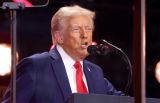NASA's LDSD Test Flight Heralds Potential Future for Unmanned Robots Exploring Mars
ByThe future of unmanned robotic exploration missions to Mars lies with NASA's flying saucer, which is undergoing a test flight Monday.
According to Reuters, the space agency released its Low-Density Supersonic Decelerator (LDSD) on board a huge helium balloon from the U.S. Navy's Hawaii base. The saucer-shaped LDSD will then detach when it reaches 120,000 feet and boosters will propel it upwards another 60,000 feet.
For reference, when the LDSD begins its descent for Earth it will be five times as high in the air as commercial airplanes typically fly.
"You get to see all the same video I do, at the same time I do," Mark Adler, project manager for LDSD at NASA's Jet Propulsion Laboratory (JPL) in Pasadena, Calif., said in a press release of NASA's live streaming the test flight. "This year's test is centered on how our newly-designed supersonic parachute will perform. We think we have a great design ready for the challenge, but the proof is in the pudding and the pudding will be made live for everyone to see."
NASA can currently carry robots weighing up to about 2,200 pounds - one metric ton - which was the case for the Curiosity rover. If LDSD is successful, NASA could transport machinery weighing five metric tons.
"Landing on Mars is an extremely challenging thing to do," CBS News quoted Ian Clark, the LDSD principal investigator at JPL, telling reporters ahead of the launch Monday. "If you want to land things that are even heavier than the Mars Science Laboratory, if you want to land several tons - and as you cast your eyes to the horizon and you think about landing humans on the surface of Mars, missions that will be 10 to 15 tons, 20 tons or more - you're going to need extremely large drag devices to slow those vehicles down. We don't have those currently, and that's what LDSD is developing."
© 2025 University Herald, All rights reserved. Do not reproduce without permission.








